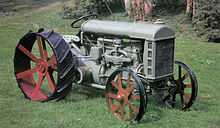Grouser
A grouser or cleat is a protrusion on the surface of a wheel or continuous track segment, intended to increase traction in soil, snow, or other loose material, in the same manner as cleated shoes provide traction to athletes. Track segments which incorporate grouser bars are known as grouser shoes, and typically include one to three grousers.[1] Grousers are commonly used on construction vehicles such as bulldozers, loaders, and excavators, as well as tanks, tractors, and snowmobiles. They have also found use in such extreme environments as the deep sea floor, and the surfaces of the Moon and Mars.[2]
Variations
Grousers may take the form of flat plates or bars, or may have more complex shapes, including spikes and involute curves, depending on the type of terrain and the performance requirements of the vehicle.[2][3] Cleats for round wheels are sometimes also called lugs, as are the protrusions molded into rubber tractor tire treads, which perform a similar function. Unlike rubber tire treads or crawler track shoe pads however, grousers are typically made of metal, such as forged steel, and are not designed for use on paved roads.[3]
Grousers may be permanently attached to, or formed as a single piece with, the track shoe, or they may be bolted onto the track shoe for ease of replacement as they become worn.
Various devices, with names such as road bands, have been developed to temporarily cover grousers/cleats in order to allow a vehicle to drive on paved roads.
The external track extensions often called "grousers" or "duckbills" that were added to the outside edges of the trackshoes on armored fighting vehicles based on the American M4 Sherman tank helped effectively widen the track for improved performance in snow or mud.[4]
Terramechanics
Grousers function by trapping soil against the contact area of the track. It is the shearing of the soil against itself that generates tractive force. The gross tractive effort, or soil thrust, of a vehicle may be calculated from the equation:[5]
where:
 soil thrust
soil thrust track width
track width contact length
contact length coefficient of cohesion (a soil property)
coefficient of cohesion (a soil property) grouser height
grouser height gross vehicle weight
gross vehicle weight
 angle of repose (a soil property)
angle of repose (a soil property)
Gallery
|
See also
- Heavy equipment (construction)
- Soil mechanics
- Terramechanics
References
- ↑ "Track Shoes". Berco of America, Inc. Retrieved 2010-02-27.
- ↑ 2.0 2.1 Hong, Sup; Jong-Su Choi (2001). "Experimental Study on Grouser Shape Effects on Trafficability of Extremely Soft Seabed" (PDF). Proceedings of the Fourth Ocean Mining Symposium. Szczecin, Poland: The International Society of Offshore and Polar Engineers. pp. 115–. Retrieved 2010-02-28.
- ↑ 3.0 3.1 "Grouser Shoes". RitchieWiki. 13 October 2009. Retrieved 2010-02-27.
- ↑ Track Grousers on M4 Sherman Tank (YOUTUBE) (YouTube). LoneSentryCom. 1944. Retrieved March 3, 2014.
- ↑ Gerhart, Grant; Sean Laughery; Richard Goetz (2006). "Off-Road Vehicle Locomotion Using Bekker's Model". Warren, MI: United States Army Tank Automotive Research, Development and Engineering Center. p. 9. Retrieved 2010-02-28.
![H = blc \left ( 1 + \frac{2h}{b} \right ) + W \tan \phi \left ( 1 + 0.64 \left [ \left ( \frac{h}{b} \right ) \cot^{-1} \left ( \frac{h}{b} \right ) \right ] \right )](../I/m/68deb7024f58eeacdc17bf0d0f2b1fef.png)


